 If BMW made a car that was sold to one billion people worldwide, and had a fatal mechanical flaw–it locked passengers into their seatbelts and suddenly accelerated uncontrollably, crashing and killing half of its owners–surely the car would be pulled immediately off the road with great scandal, and probably tarnish the company’s reputation for decades. But today, tobacco is sold to about one billion people worldwide and kills almost half of them; it requires about five to seven attempts on average to quit smoking because of addictive materials in tobacco products; and while sales have diminished in the United States, they are accelerating and even being sponsored by governments in some low- and middle-income countries, where 80% of smokers live. In 2003, the World Health Organization signed the first global health treaty, the Framework Convention on Tobacco Control (FCTC), legally binding 174 signing countries to minimum standards that govern the production, sale, distribution, advertisement, and taxation of tobacco. In this week’s post, we look at data from the tobacco industry itself to understand how well efforts like the FCTC are working, and to determine where greater efforts in tobacco control may be needed in the future.
If BMW made a car that was sold to one billion people worldwide, and had a fatal mechanical flaw–it locked passengers into their seatbelts and suddenly accelerated uncontrollably, crashing and killing half of its owners–surely the car would be pulled immediately off the road with great scandal, and probably tarnish the company’s reputation for decades. But today, tobacco is sold to about one billion people worldwide and kills almost half of them; it requires about five to seven attempts on average to quit smoking because of addictive materials in tobacco products; and while sales have diminished in the United States, they are accelerating and even being sponsored by governments in some low- and middle-income countries, where 80% of smokers live. In 2003, the World Health Organization signed the first global health treaty, the Framework Convention on Tobacco Control (FCTC), legally binding 174 signing countries to minimum standards that govern the production, sale, distribution, advertisement, and taxation of tobacco. In this week’s post, we look at data from the tobacco industry itself to understand how well efforts like the FCTC are working, and to determine where greater efforts in tobacco control may be needed in the future.
Trends in smoking prevalence
The best available data on tobacco use describes trends in cigarette smoking among adults. Smoking prevalence among adults has markedly diverged among disparate countries over the past decade. Using industry data from 1997 to 2010, it’s clear that a few countries have markedly reduced the proportion of adults who smoke cigarettes, having lowered smoking prevalence by 10% or more: Norway (from 33% of adults smoking in 1997 to 19% smoking in 2010), South Korea (from 35% to 21% during that period), Slovenia (from 36% to 24%), Japan (from 36% to 25%) and Denmark (from 32% to 22%). The latest tobacco control reports from these countries indicate that they implemented tax policies to reduce tobacco consumption (most instituted a combination of a specific tax–like a tax per quantity of cigarettes sold–and ad valorem taxes–which are like sales taxes taking a percentage of the sales price). The countries also confiscated equipment and supplies related to illicit tobacco trading, banned smoking in a number of public places, and enforced various package labeling requirements. Denmark and Slovenia even implemented a comprehensive ban on all tobacco advertising, promotion and sponsorship. It would be interesting to conduct an analysis of which measures may have contributed most to the decline in smoking prevalence among these nations, as compared with less successful countries.
It’s intriguing that a couple of these more successful countries are from Eastern Europe and Southeast Asia, as their next-door neighbors dominate the list of countries where more than one-third of adults still smoke (see the table below). This implies that cultural or regional economic factors are not insurmountable barriers to effective tobacco control. But Eastern Europe and the Middle East do face significant challenges; a few countries have experienced more than a 5% increase in adult smoking prevalence from 1997 to 2010, specifically Romania (from 19% of adults smoking in 1997 to 28% in 2010), Iran (from 11% to 19% during that period) and Saudi Arabia (from 23% to 30%). While all three of these countries signed the FCTC, none of them have turned in their requested reports on FCTC progress, which were due earlier this year.
The highest overall prevalence rates in the world are among Russians (43% of adults smoking in 2010), Greeks (40% in 2010), and Bosnians (39%), followed by Bulgarians (38%) and Macedonians (36%). These countries are also FCTC signatories, but Russia just started its implementation process in 2008. Greece, Macedonia and Bosnia are overdue in reporting its FCTC progress, suggesting that lack of political will to generate regulation may be a common theme among countries with higher or rising smoking rates.
The tobacco industry has arrived at its own projections for where tobacco smoking prevalence is likely to rise and fall in the future. The available projections span five years, and predict the largest declines in adult smoking prevalence in the Ukraine (from 29% smoking prevalence in 2010 to 24% in 2015), Cameroon (from 13% to 9% during that time period), Serbia (30% to 27%), Norway (19% to 15%) and New Zealand (21% to 18%). Of 80 countries for which data are available, 63 are anticipated to experience declines in smoking prevalence and three are expected to have no significant change in prevalence over the next five years. The few countries who are projected by the industry to have a significant rise in future smoking prevalence over the next half decade are in Africa and the Middle East: Morocco (increasing prevalence from 20% in 2010 to 29% in 2015), Kenya (20% to 23%), Tunisia (36% to 38%), Iran (19% to 21%) and Saudi Arabia (30% to 31%). Kenya has implemented FCTC provisions since 2004 and kept up to date with all of its reporting, while the other countries anticipated to face a rise in prevalence have failed to report on their progress in ratifying the treaty’s provisions.
The overall adult prevalence statistics from these countries, however, disguise a striking demographic feature hidden beneath the averaged data. That is, there is a marked difference within countries between how much adult men smoke and how much adult women do. In several countries, male smoking rates are at least twice the rates among women. In Russia, for example, 62% of adult men smoked in 2010, while about 29% of women did. Similarly, 61% of Tunisian men, 48% of Chinese men and 24% of Indian men smoked, while the rates of smoking among women in those countries was 11%, 3% and 4%, respectively. There are a few locations where prevalence rates of smoking among women are strikingly high, but still not as high as among men (33% of Bosnian women, for example, smoke, as compared to 46% of Bosnian men).
To get a better look at tobacco industry data, see the WHO’s online database. To find out what tobacco controls from the FCTC provisions have been implemented in different countries, click here. You can also access individual country reports describing FCTC implementation progress here.
Actual sticks sold
Because prevalence statistics simply reflect the proportion of a country’s population that smokes, the statistics make it hard to visualize how many actual people are affected, which is conditional upon the population size of the country. And even the absolute number of smokers doesn’t give a sense of the full public health impact of smoking, since cigarette smoke exhibits a “dose-response” effect on negative outcomes like heart and lung disease, such that an individual with a longer and heavier smoking history will have a greater likelihood of experiencing tobacco-related disease than someone with a brief or light smoking history. The number of actual cigarette sticks sold can therefore give some sense of the burden of cigarettes around the world, capturing some aspects of both the population size and the dosage of cigarette exposure affecting different countries or regions.
When we look at the number of cigarettes sold by region and by country (figures below), we see the true impact of Chinese tobacco use on the overall global tobacco epidemic. While other countries have a greater absolute smoking prevalence, China’s moderately high prevalence (26% of adults smoking in 2010) translates into an effectively very large market of consumers given the country’s massive population size. Of greater concern is that while the absolute smoking prevalence in the country has remained essentially flat for the last decade (and is projected to remain flat at 26% for the next five years according to the industry’s own projections) the number of sticks sold in China has increased dramatically and continues to rise on an exponential upward trajectory that is about five times faster than the population curve, suggesting heavier smoking over time. Overall, 2.3 million cigarettes were sold in China last year, which is projected to rise to 2.8 million by 2015. When China is removed from the figures, we can see more clearly that cigarette sales have declined in North America, Western Europe and Latin America, plateaued in Eastern Europe to some extent, and rose in the Middle East and Africa. Among the top cigarette consuming nations, the US and Japan have markedly lowered their consumption over the past decade or so, while Russia and Indonesia have increased their cigarette consumption, also beyond their population growth curves, as with China.
Corporate market shares
It’s interesting to look at which key companies own different shares of the global cigarette market. Given the size of the Chinese industry, it’s not surprising that the China National Tobacco Corporation owns the majority share (40% of the global market in 2010), and is increasing its share over time (it owned 32% of the global cigarette market in 2001). Philip Morris (aka Altria) has released its data more recently, and comes in second (at 15% of the global market in 2010), followed by British American Tobacco (12%) then Japan Tobacco (10%) and Imperial Tobacco (5%).
But such aggregate global market share data are not reflective of stark regional differences. In every region outside of Asia, Philip Morris/Altria and British American Tobacco dominate the marketplace (see table below). Morris/Altria is dominant in Eastern Europe (29% share), North America (43%) and Western Europe (37%), while British American Tobacco is dominant in Latin America (54% share) and the Middle East and Africa (22%). Ultimately this means that, worldwide, Marlboros are the most smoked cigarette (consumed by 5.1% of the market), followed by Hongtashan (2.5%) because of the Chinese consumer market.
What’s missing
The data on non-cigarette tobacco products is limited. Smokeless tobacco seems to be increasingly popular in some countries, but the industry rarely advertises these statistics. We also lack clear industry data on tobacco use among youth (probably because they don’t want to advertise that they collect such data), the WHO has kept track of tobacco use estimates among the young as part of its MPOWER initiative. Of course, official industry statistics are usually from large national or multinational corporations, while many cigarettes are sold through smaller-scale and under-the-table initiatives, as with the cottage industry of Indian bidis. These informal tobacco products can sometimes contain higher dangerous carcinogenic content than mass-manufactured cigarettes.
Enforcing the FCTC
There have been extensive reviews of “what works” in tobacco control, so we will not rehash that full literature here. The FCTC website briefly summarizes the critical findings from years of research: that while a minority of smokers know the dangers of smoking, most of those who know about the dangers want to quit but have difficulty doing so; that smoking cessation products can significantly increase the likelihood of quitting; that picture warnings on packages reduce the number of children who begin smoking and increase the number of smokers who quit; that bans on advertising significantly reduce tobacco consumption; and that taxes are the most effective way to reduce tobacco use, especially among the young and among the poor.
What the industry’s data on tobacco sales reveal is additional useful information:
(1) That most countries are expected to reduce their overall adult smoking prevalence over the next several years;
(2) But some North African and Middle Eastern countries may see perverse increases in adult smoking rates, and have exhibited limited reporting to the FCTC Conference of Parties, which is charged with enforcing the treaty. Are there teeth to ensure their participation in the treaty’s mandates? Bad press may be a main avenue for action, along with reporting the significant human and financial costs of maintaining high tobacco prevalence rates;
(3) High smoking rates in Eastern Europe can be tackled effectively by existing strategies, as demonstrated by Slovenia;
(4) But China remains it’s own unique animal, with a massive and politically well-connected tobacco producer expanding its markets, and indications that heavier cigarette consumption is taking place in the country over time, pushing up regional and worldwide tobacco use statistics.
The signing of the FCTC by 174 countries serves as an incredible precedent for global health cooperation and regulation. The question now is whether we can sustain interest and concern in tobacco control to actually enforce the treaty’s contents, given that tobacco has been viewed as a previous generation’s problem in North America and Western Europe, but remains one of the top risk factors for disease in most of the world.
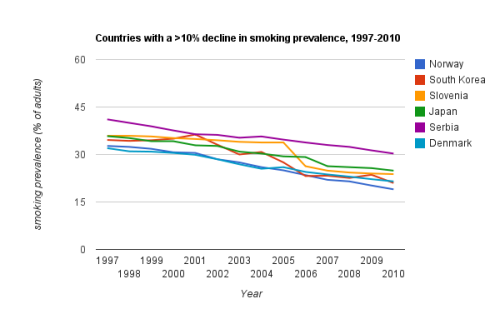
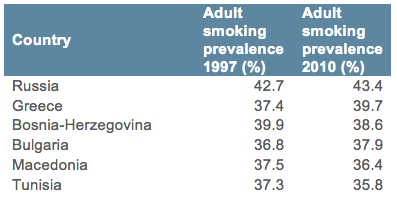
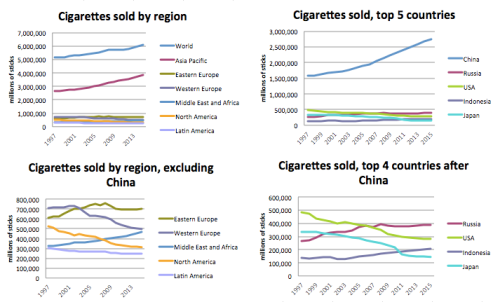
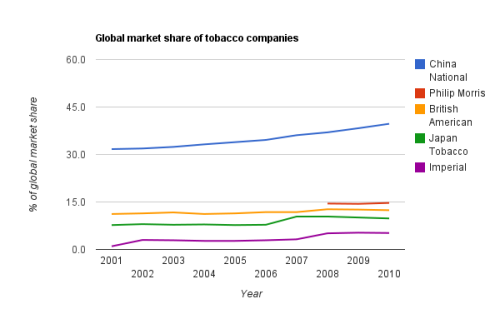
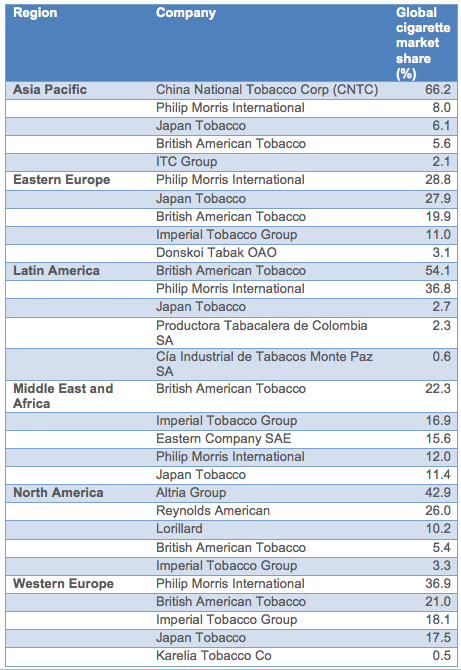

Beautiful Analysis! I never knew that the increase in smoking in China is the reason behind the false perception that smoking is increasing in the world!
Pingback: Alcohol use around the globe: new data trends | [ EpiAnalysis ]